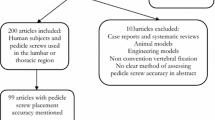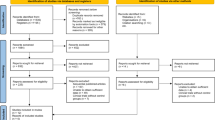Abstract
A number of studies have shown increased accuracy of pedicle screw placement in spine with the help of computer-assisted navigation. The literature is lacking in regard to functional benefit derived from this technique. The aim of this systematic review was to look at the functional outcomes following computer-assisted pedicle screw placement in spine. A ‘Dialog Datastar’ search was used using optimized search strategy covering the period from 1950 to July 2009; 23 papers were finally included which met our inclusion criteria. We report on a total of 1,288 patients with 5,992 pedicle screws. The comparison of neurological complications in two groups demonstrated an odds ratio of 0.25 (95% CI 0.06, 1.14) in favour of using navigation for pedicle screw insertion (p = 0.07). Comparative trials demonstrated a significant advantage in terms of accuracy of navigation over conventional pedicle screw insertion with a relative risk of 1.12 (95% CI 1.09, 1.15) (p < 0.00001). Navigation does not show statistically significant benefit in reducing neurological complications and there was insufficient data in the literature to infer a conclusion in terms of fusion rate, pain relief and health outcome scores.


Similar content being viewed by others
References
Gertzbein SD, Robbins SE (1990) Accuracy of pedicular screw placement in vivo. Spine 15:11–14
Castro WH, Halm H, Jerosch J, Malms J, Steinbeck J, Blasius S (1996) Accuracy of pedicle screw placement in lumbar vertebrae. Spine 21:1320–1324
Laine T, Makitalo K, Schlenzka D, Tallroth K, Poussa M, Alho A (1997) Accuracy of pedicle screw insertion: a prospective CT study in 30 low back patients. Eur Spine J 6:402–405
Holly LT, Foley KT (2007) Image guidance in spine surgery. Orthop Clin North Am 38:451–461 (abstract viii)
Youkilis AS, Quint DJ, McGillicuddy JE, Papadopoulos SM (2001) Stereotactic navigation for placement of pedicle screws in the thoracic spine. Neurosurgery 48:771–778 (discussion 778–779)
Richter M, Amiot LP, Neller S, Kluger P, Puhl W (2000) Computer-assisted surgery in posterior instrumentation of the cervical spine: an in vitro feasibility study. Eur Spine J 9:S65–S70
Kosmopoulos V, Schizas C (2007) Pedicle screw placement accuracy: a meta-analysis. Spine 32:E111–E120. doi:10.1097/01.brs.0000254048.79024.8b
Laine T, Schlenzka D, Makitalo K, Tallroth K, Nolte LP, Visarius H (1997) Improved accuracy of pedicle screw insertion with computer-assisted surgery. A prospective clinical trial of 30 patients. Spine 22:1254–1258
Schwarzenbach O, Berlemann U, Jost B, Visarius H, Arm E, Langlotz F, Nolte LP, Ozdoba C (1997) Accuracy of computer-assisted pedicle screw placement. An in vivo computed tomography analysis. Spine 22:452–458
Moher D, Cook DJ, Eastwood S, Olkin I, Rennie D, Stroup DF (1999) Improving the quality of reports of meta-analyses of randomised controlled trials: the QUOROM statement. Quality of reporting of meta-analyses. Lancet 354:1896–1900
Downs SH, Black N (1998) The feasibility of creating a checklist for the assessment of the methodological quality both of randomised and non-randomised studies of health care interventions. J Epidemiol Community Health 52:377–384
Bostelmann R, Benini A (2004) Computer-assisted surgery (CAS) in transpedicular lumbar fusion. Experiences of the Spinal Neurosurgery Department. Schweiz Rundsch Med Prax 93:96–102
Amiot LP, Lang K, Putzier M, Zippel H, Labelle H (2000) Comparative results between conventional and computer-assisted pedicle screw installation in the thoracic, lumbar, and sacral spine. Spine 25:606–614
Girardi FP, Cammisa FP Jr, Sandhu HS, Alvarez L (1999) The placement of lumbar pedicle screws using computerised stereotactic guidance. J Bone Jt Surg Br 81:825–829
Schnake KJ, Konig B, Berth U, Schroeder RJ, Kandziora F, Stockle U, Raschke M, Haas NP (2004) Accuracy of CT-based navigation of pedicle screws in the thoracic spine compared with conventional technique. Unfallchirurg 107:104–112. doi:10.1007/s00113-003-0720-8
Seichi A, Takeshita K, Nakajima S, Akune T, Kawaguchi H, Nakamura K (2005) Revision cervical spine surgery using transarticular or pedicle screws under a computer-assisted image-guidance system. J Orthop Sci 10:385–390. doi:10.1007/s00776-005-0902-z
Rajasekaran S, Perumal Ramesh SV, Shetty AP (2007) Randomized clinical study to compare the accuracy of navigated and non-navigated thoracic pedicle screws in deformity correction surgeries. Spine 32:E56–E64
Seller K, Wild A, Urselmann L, Krauspe R (2005) Prospective screw misplacement analysis after conventional and navigated pedicle screw implantation. Biomed Tech (Berl) 50:287–292
Kotani Y, Abumi K, Ito M, Minami A (2003) Improved accuracy of computer-assisted cervical pedicle screw insertion. J Neurosurg 99:257–263
Merloz P, Troccaz J, Vouaillat H, Vasile C, Tonetti J, Eid A, Plaweski S (2007) Fluoroscopy-based navigation system in spine surgery. Proc Inst Mech Eng [H] 221:813–820
Ito H, Neo M, Yoshida M, Fujibayashi S, Yoshitomi H, Nakamura T (2007) Efficacy of computer-assisted pedicle screw insertion for cervical instability in RA patients. Rheumatol Int 27:567–574. doi:10.1007/s00296-006-0256-7
Schlenzka D, Laine T, Lund T (2000) Computer-assisted spine surgery. Eur Spine J 9(Suppl 1):S57–S64
Merloz P, Tonetti J, Pittet L, Coulomb M, Lavallee S, Troccaz J, Cinquin P, Sautot P (1998) Computer-assisted spine surgery. Comput Aided Surg 3:297–305. doi:10.1002/(SICI)1097-0150(1998)3:6<297:AID-IGS3>3.0.CO;2-8
Richter M, Mattes T, Cakir B (2004) Computer-assisted posterior instrumentation of the cervical and cervico-thoracic spine. Eur Spine J 13:50–59. doi:10.1007/s00586-003-0604-1
Rampersaud YR, Pik JH, Salonen D, Farooq S (2005) Clinical accuracy of fluoroscopic computer-assisted pedicle screw fixation: a CT analysis. Spine 30:E183–E190
Richter M, Cakir B, Schmidt R (2005) Cervical pedicle screws: conventional versus computer-assisted placement of cannulated screws. Spine 30:2280–2287
Kamimura M, Ebara S, Itoh H, Tateiwa Y, Kinoshita T, Takaoka K (1999) Accurate pedicle screw insertion under the control of a computer-assisted image guiding system: laboratory test and clinical study. J Orthop Sci 4:197–206
Laine T, Lund T, Ylikoski M, Lohikoski J, Schlenzka D (2000) Accuracy of pedicle screw insertion with and without computer assistance: a randomised controlled clinical study in 100 consecutive patients. Eur Spine J 9:235–240
Kotani Y, Abumi K, Ito M, Takahata M, Sudo H, Ohshima S, Minami A (2007) Accuracy analysis of pedicle screw placement in posterior scoliosis surgery: comparison between conventional fluoroscopic and computer-assisted technique. Spine 32:1543–1550. doi:10.1097/BRS.0b013e318068661e
Lee GY, Massicotte EM, Rampersaud YR (2007) Clinical accuracy of cervicothoracic pedicle screw placement: a comparison of the “open” lamino-foraminotomy and computer-assisted techniques. J Spinal Disord Tech 20:25–32. doi:10.1097/01.bsd.0000211239.21835.ad
Roy-Camille R, Saillant G, Mazel C (1986) Internal fixation of the lumbar spine with pedicle screw plating. Clin Orthop Relat Res, pp 7–17
Ludwig SC, Kramer DL, Vaccaro AR, Albert TJ (1999) Transpedicle screw fixation of the cervical spine. Clin Orthop Relat Res, pp 77–88
Ferguson RL, Tencer AF, Woodard P, Allen BL Jr (1988) Biomechanical comparisons of spinal fracture models and the stabilizing effects of posterior instrumentations. Spine 13:453–460
Schulze CJ, Munzinger E, Weber U (1998) Clinical relevance of accuracy of pedicle screw placement. A computed tomographic-supported analysis. Spine 23:2215–2220 (discussion 2220–2211)
Greenland S (1994) Can meta-analysis be salvaged? Am J Epidemiol 140:783–787
Greenland S (1994) Invited commentary: a critical look at some popular meta-analytic methods. Am J Epidemiol 140:290–296
Altman DG, Bland JM (1995) Absence of evidence is not evidence of absence. BMJ 311:485
Arand M, Hartwig E, Hebold D, Kinz L, Gebhard F (2007) Precision analysis of naviagation assisted implanted thoracic and lumbar pedicled screws. A prospective clinical study. Unfallchirurg 104(11):1076–1081
Author information
Authors and Affiliations
Corresponding author
Rights and permissions
About this article
Cite this article
Verma, R., Krishan, S., Haendlmayer, K. et al. Functional outcome of computer-assisted spinal pedicle screw placement: a systematic review and meta-analysis of 23 studies including 5,992 pedicle screws. Eur Spine J 19, 370–375 (2010). https://doi.org/10.1007/s00586-009-1258-4
Received:
Accepted:
Published:
Issue Date:
DOI: https://doi.org/10.1007/s00586-009-1258-4




